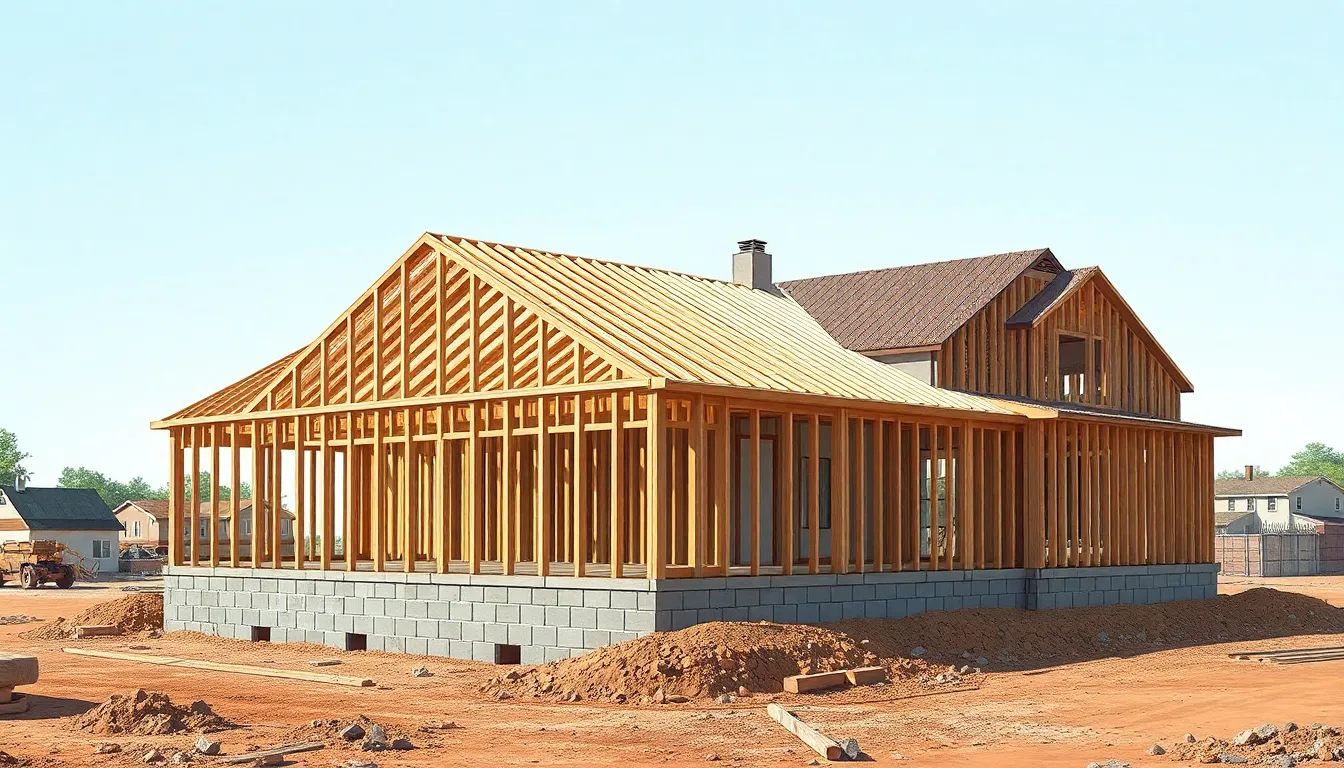Table of Contents
ToggleBuilding construction is like a giant puzzle, where every piece matters. From the foundation to the roof, each element plays a crucial role in creating a sturdy structure. But let’s face it—most people only think about construction when they’re stuck in traffic behind a bulldozer or when their neighbor decides to build a fortress that blocks the sun.
Overview of Building Construction Illustrated
Building construction involves a complex interplay of various elements, each critical to the integrity of the final structure. Foundations serve as the base, supporting everything above. Framing follows, providing the skeletal framework essential for walls and roofs. Every phase demands precision, as even minor errors can lead to significant consequences.
Materials play a vital role in this process. Concrete, wood, steel, and glass each offer distinct advantages and weaknesses. For instance, concrete’s durability makes it a popular choice for foundations, while wood provides versatility during framing. Understanding material properties ensures that builders select the right components for each project.
Collaboration among professionals also enhances the construction process. Architects, engineers, contractors, and subcontractors must communicate effectively to align their visions and goals. By working together, they create a seamless transition from design to execution. Regular meetings and updates often keep everyone on the same page.
Permits and regulations govern construction practices in different jurisdictions. These legal frameworks outline safety standards and environmental considerations that builders must follow. Adhering to these regulations not only protects workers but also ensures community safety.
Grasping the fundamentals of building construction illustrates that it’s more than just assembling materials. It’s a careful orchestration of planning, execution, and regulatory compliance. Each component, from the foundation to the roof, contributes to a strong, functional, and safe structure. Understanding these elements equips individuals with the knowledge to appreciate the complexities involved in construction projects.
Key Features of the Book

This book presents key features that enhance understanding of building construction. Its detailed content provides insights into the complexities of constructing structures.
Comprehensive Illustrations
Comprehensive illustrations visually represent each construction phase. Diagrams highlight essential elements such as foundations, framing, and roofing. Visual aids clarify concepts, showcasing how components interact within a structure. Each illustration effectively supports the text, making complex ideas more accessible. Readers find it easier to grasp vital processes, improving overall comprehension. This visual approach engages the audience, facilitating learning through imagery.
Detailed Explanations
Detailed explanations accompany each illustration, providing in-depth insights into materials and techniques. Clear descriptions outline the purpose and function of various components in construction. Specifications on concrete, wood, and steel illustrate their distinct properties and applications. Readers gain a thorough understanding of the necessary steps involved in construction. Technical terms are defined plainly, ensuring clarity for all audience levels. This combination of visuals and text fosters a deeper knowledge of construction practices and policies.
Importance of the Content
Understanding building construction is crucial for various stakeholders involved in the industry. This content enhances awareness of construction processes and their impacts, allowing people to appreciate the complexities of creating structures.
For Students and Professionals
Students benefit from learning about construction concepts through visual aids and clear explanations. Incorporating detailed visuals helps them grasp intricate relationships between elements, supporting their academic growth. Professionals gain insights into current practices and techniques, aiding their skill development. Resources that blend illustrations with thorough descriptions foster a comprehensive grasp of foundational principles.
For Industry Practitioners
Industry practitioners rely on this content to stay updated on trends and innovations in construction. Visual representations combined with expert insights improve their understanding of material choices and building techniques. Accessing this information streamlines collaboration with architects and engineers. Practitioners equipped with knowledge of regulations and safety standards enhance their ability to navigate complex projects efficiently.
Strengths of Building Construction Illustrated
The strengths of building construction illustrated enhance understanding of complex construction processes. They provide essential insights into various construction phases.
Clarity and Accessibility
Visual elements simplify intricate concepts within building construction. Each illustration offers a clear depiction of construction phases, making it easier for readers to grasp vital information. Explanations paired with visuals break down complex techniques and materials. This format caters to diverse audiences, from students to industry professionals. Readers engage with content that feels approachable and informative. Undoubtedly, this clarity fosters a greater appreciation for the construction process.
Practical Applications
Applications in real-world scenarios showcase the utility of illustrated construction content. Students leverage visuals for academic projects and deeper learning. Professionals gain practical insights that enhance skills and inform decision-making. These illustrations serve as valuable references during project planning and execution. By providing examples of construction techniques and materials, the content aids in identifying best practices. Stakeholders find it easier to communicate ideas and collaborate effectively.
Areas for Improvement
Building construction content presents opportunities for enhancement in various aspects. Identifying potential gaps can lead to a more comprehensive understanding of the subject.
Potential Gaps in Content
Some illustrations lack detailed explanations, which may leave readers confused about specific construction techniques. Critical phases of construction such as site preparation and finishing touches receive minimal attention. Further, the content often overlooks emerging technologies that influence modern construction methods. By addressing these areas, readers can gain a complete view of the construction process and its evolution.
Suggested Enhancements
Incorporating additional illustrations would significantly benefit the audience’s grasp of complex concepts. Linking practical examples to theoretical content could help reinforce learning. Providing case studies that reflect real-world scenarios contributes valuable context to material choices. Including expert interviews would introduce different perspectives on industry trends, fostering deeper insights. Improving accessibility by utilizing various formats can reach broader audiences.
Building construction is far more than just assembling materials; it’s a meticulous process that requires precision and collaboration. Each phase contributes to the overall integrity of the structure, making understanding these elements crucial for anyone involved or interested in the field. Illustrated content serves as a vital resource that demystifies complex concepts and enhances comprehension for students and professionals alike.
By improving accessibility and incorporating diverse perspectives, stakeholders can further appreciate the intricacies of construction. As the industry continues to evolve, staying informed about the latest practices and innovations will empower individuals to navigate the challenges of building construction effectively.







